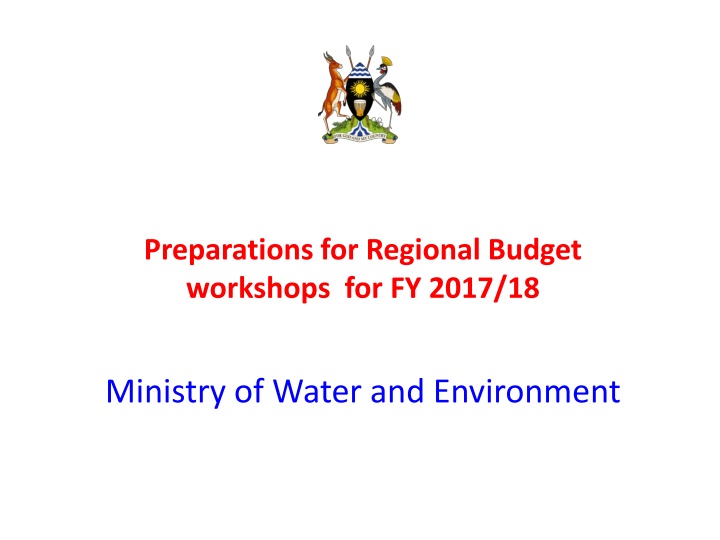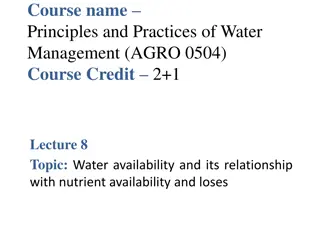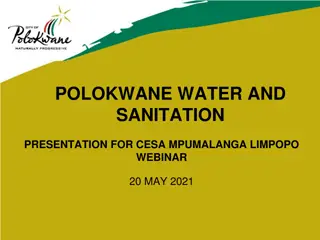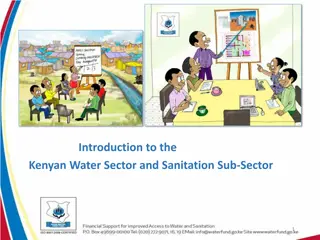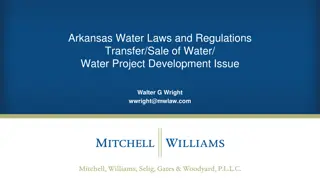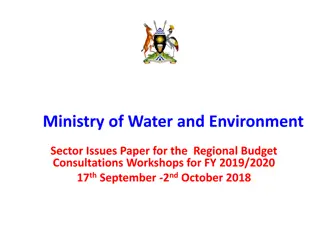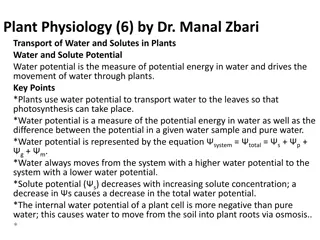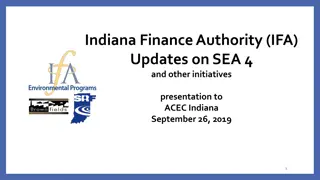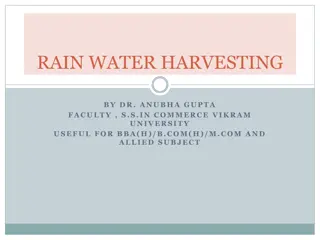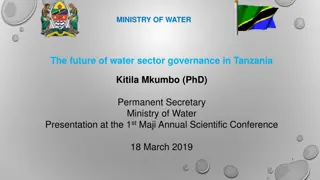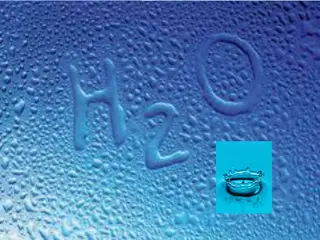Strategic Focus on Water and Environment Sector Development
The preparations for regional budget workshops for FY 2017/18 at the Ministry of Water and Environment are geared towards achieving key sector priorities and milestones. These include enhancing access to clean water and sanitation, promoting integrated water resources management, and increasing automation of climate monitoring, among other objectives outlined in the National Development Plan II. The sector aims to provide sustainable water solutions, modernize agriculture through water supply development, and manage natural resources efficiently for socio-economic development.
Download Presentation

Please find below an Image/Link to download the presentation.
The content on the website is provided AS IS for your information and personal use only. It may not be sold, licensed, or shared on other websites without obtaining consent from the author.If you encounter any issues during the download, it is possible that the publisher has removed the file from their server.
You are allowed to download the files provided on this website for personal or commercial use, subject to the condition that they are used lawfully. All files are the property of their respective owners.
The content on the website is provided AS IS for your information and personal use only. It may not be sold, licensed, or shared on other websites without obtaining consent from the author.
E N D
Presentation Transcript
Preparations for Regional Budget workshops for FY 2017/18 Ministry of Water and Environment
Overview of the 2017/18 Grant Information and Budget Guidelines The structure of the presentation: 1. 2. 3. 4. 5. 6. Policy priorities/sector objectives Sector Linkage to National Development Plan II (2015-2020) Structure and Purpose of Sector Transfers Allocation Formulae Budget Requirements Other Sectoral Issues
Sector Priorities and Milestones The Sector priorities are aimed to achieve the Vision 2040, NDPII, the NRM-Manifesto-2016/21 in totality as well as the SDGs) especially Goals 6, 13 and 15. Increase access to clean and safe water in rural areas from the current 65% to 79 % (2019/20) within a radius of 1Km with the aim of providing a water source in every village. Increase access to clean and safe water in urban areas from the current 77% to 100 % (2019/20) by increasing piped water coverage in both small and big towns. Increase access to improved sanitation in rural areas from 69% to 77% (2019/20) and from 77% to 100% (2019/20) for urban areas. Promote Integrated Water Resources Management in all development activities for sustainable water resources country-wide. Improve access to Water for Production and increase cumulative storage from the current 27.8MCM to 55MCM (2019/20) for multipurpose use, including; irrigation, livestock, aquaculture and rural industries through construction and rehabilitation of large and small water reservoirs.
Sector Priorities and Milestones Increase automation of climate monitoring network from 10 percent to 40 percent by 2019/20. Integrate climate change policy interventions in all sector development plans. Increase the country s forest cover from 10% to 18% by 2019/20. through massive tree planting of 100-200 million trees annually country wide Increase the country s wetlands cover from 10.9% to 12% by 2019/20. through restoration and demarcation of wetlands.
Sector objectives The overall Strategic objectives for Water and Environment Sector are: To provide sustainable provision of safe water within easy reach and hygienic sanitation facilities, based on management responsibility and ownership by the users, Promote development of water supply for agricultural production in order to modernize agriculture and mitigate effects of climatic variations on rain fed agriculture To manage and develop the water resources of Uganda in an integrated and sustainable manner, so as to secure and provide water of adequate quantity and quality for all social and economic needs of the present and future generations with the full participation of all stakeholders and To increase productivity of the natural resource base and harnessing natural resources in a sustainable manner 5
Key Sector Outcomes Indicators Outcome 1: Increased access to quality safe water and sanitation facilities for rural, urban water for improved production and livelihoods. Outcome 2: Increased provision and utilization of WfP facilities to enhance production and productivity and socio-economic transformation. Outcome 3: Improved and adequate water quality and quantity for all water users in the country. Outcome 4: Improved weather, climate and climate change management, protection and restoration of environment and natural resources.
Relations between National Development Plan (NDP-II) and Sector Objectives The Water and Environment Sector is a cross-cutting sector and therefore central in contributing to the achievements of all the NDP goal which is transformation of Uganda towards middle income status by 2020. The sustainability of key fundamental enablers/drivers of socio-economic transformation such as Hydro-Power production and productivity, Livestock, Fisheries, Health, Industrial development, Human Capital Development, Tourism Development and Mitigation of Climate and Climate Change effects depend on availability of adequate water and sustainable management of ENR. Development, Agricultural Likewise, a healthy, clean and productive environment is essential in boosting wealthy creation for social transformation and attainment of the middle income status by 2020.
Relations between National Development Plan (NDP-II) and Sector Objectives Over the NDP period, therefore the Water and Environment sector implementation of sector priorities and objectives, interventions, outcomes, targets aimed at increased access to safe water and sanitation in rural and urban areas, increased water storage for multi-purpose use, and promotion of sustainable utilization of natural resources for improved livelihood in the country. will focus on
Structure and Purpose of Sector Transfers Grant Purpose Non-Wage Conditional Grant o/w Rural Water and Sanitation Deliver sanitation and hygiene outreach and information dissemination around water points; management of the water sector. Funds earmarked for protection of wetlands, demarcation, restoration and enforcement of wetlands laws and regulations in LGs. o/w Natural Resources & Environment Development Conditional Grant Water and Environment Provision and rehabilitation of rural water infrastructure that enables access to clean and safe water. Transitional and Support Services Grant o/w Support Services Non-Wage Recurrent - Urban Water Funds the O&M of piped water systems in towns within a district, bridging the gap between local revenue collection and operation costs. This fund is earmarked for sanitation activities in a limited number of districts. Temporary and Piloted o/w Transitional Development - Sanitation 9
Key Variables Used in Allocation Formulae Variable name Weightings RWS NW NRM NW Devt Fixed Allocation 82 0 30 Justification To cover the fixed costs of a District Water Office and ensure a minimum investment allocation for each local government. To cover the operation, maintenance and rehabilitation of existing water supplies This adds weight to the most under-served areas within a local government, to target funding to areas which are most lagging behind the sector target. The figures are capped, to limit the total availability of funding to LGs and ensure absorption of funds. Rural Population Rural Un served Population for SCs with below 77 per-cent capped at 50,000 Estimated Cost of Providing Per Capita Land Area/wetland area Served 0 0 20 0 0 45 Coverage 0 0 5 The cost of delivering water facilities varies greatly across the country due to geographical and other factors. This indicator compensates for these variations. Land area is considered a proxy for the scale of natural resources management activities. The bigger the wetland covered in the district the bigger the weight. This implies that there is more resources required to managed the wetland resource. Those areas which are hard to reach are more costly to deliver services to and therefore are given priority. Water 10 45 0 Population in Hard to Reach Hard to Stay Areas Rural Population 3 5 0 5 40 0 Indicator of scale of rural water and sanitation services required. Similarly for the environment sector. The higher the population the more people requiring services. The higher the population, the more people requiring the services. The wetland has a bigger weight, the higher the popn. In that area, the higher the chances of degradation and therefore will need more money for restoration, demarcation and awareness This is used as a proxy for need for natural resource management services, targeting allocations on the poorest areas. There is more money required for sensitisation of the popn on the wise use of Poverty Headcount 0 10 0 10
Overview of the Issues in the 2016/17 budget guidelines and how they were addressed (1/n) Issue How addressed Non wage Recurrent: The new allocation to the districts cannot accommodate office running In some districts procurement of new vehicles to facilitate supervision of field activities. Review the overall 14% guidelines for overall wage, non-wage and recurrent, monitoring administration, to accommodate purchase of vehicles and hiring of contact staff. and including The investment servicing costs such as feasibility procurement inadequate. 5% earmarked for The funds to cater for investment servicing costs should be part of the development (infrastructure e.g. water points, public toilets, facilities, etc.). studies costs and budget is piped water
Overview of Budget Requirements for 2017/18 (1/n) Budget Requirements Narrative performance contract Summary of Budget Principles and Requirements The budget narrative summarises information on revenue, expenditure and key outputs in the performance contract. The budget must adhere to the guidelines. Total Work plan revenues and expenditures balance and are divided correctly between wage, non-wage recurrent, GoU and donor development. Salaries must be funded from the Unconditional Wage Grant, within the overall staff and budget ceilings. Salary allocations to the water and environments departments must be according to the filled posts within the approved structure, recruitment plan and salary scales within a given financial year. At least the following key positions should be budgeted for under the Natural Resources department: Environment Officer, Lands Officer, Physical planner, Registrar of titles and Overview of Work plan Revenues Expenditure Salaries and costs and related Natural Resources Officer,
Overview of Budget Requirements for 2017/18 Budget Requirements Salaries related costs Summary of Budget Principles and Requirements The following positions must be budgeted for under the water department: 1 Water Engineer, 1 Engineering Assistant (Water/Borehole Technician), 4 Assistant Water Officers ( for water supply, mobilisation, sanitation and for planning) If these posts are not funded from the unconditional wage grant, they should be budgeted for as contract staff in the development budget funded from the sector development grant. In line with allocations to the support services grant- urban water, allocations should be made to urban settlements and RGCs. The full amount of grant allocations from the Support Services Urban O&M grant should be allocated as Lower Local Services to the piped water schemes and umbrella organisations identified by MWE. and Lower Services (Operation and maintenance of water systems in settlements/R GCs) Local piped Routine maintenance, including minor repairs, remains the responsibility of communities and associated water user committees within each sub-county. urban Note that this is only applicable to LGs receiving the Support Services Grant for Urban Water
Overview of Budget Requirements for 2017/18 Budget Requirements Higher Services (Promotion of sanitation hygiene community- based mobilisation) Monitoring, management and administratio n of service delivery Summary of Budget Principles and Requirements A minimum of 40% of the non-wage recurrent budget for rural water and sanitation should be allocated to: o Promotion of sanitation and hygiene o Mobilisation and promotion of community based maintenance of water sources For those local governments receiving funds from the Transitional Development Sanitation grant, additional allocations should be made in the development budget to sanitation activities. Up to 40% of the non-wage recurrent budget of for rural water and sanitation should be allocated to: o The operation costs of District Water Offices o Coordination activities o Routine monitoring of water sector activities Overall, wage, non-wage recurrent and development management, monitoring and administration of service delivery, should not exceed 14% of the sector recurrent and GoU development budgets combined. Local , and
Overview of Budget Requirements for 2017/18 Budget Requirements Capacity Development Summary of Budget Principles and Requirements No funds from sector conditional grants can be spent on capacity development (for staff). Training and capacity development will be provided by the centre. LGs may also provide for capacity development using their own local revenue, the DDEG, and other transfers. Capacity building activities should be consistent with the positive and negative lists (A table listing these is part of these guidelines) Overall, a maximum of 15% of the Sector GoU development Budget for the Water Department can be allocated to rehabilitation or major repair of water sources at both the sub-county and district levels. A minimum 80% of the sector GoU development budget should be allocated to capital such as infrastructure, facilities and equipment. Specific facilities include: Water sources/points, Public toilets, Dams All sub-counties with water coverage below the national target level should be allocated at least 75% of their share of the cost of achieving the sector target. Up to 5% of the value of sector infrastructure investments can be allocated to investment servicing costs, including feasibility studies, procurement and monitoring costs. Local governments may not budget for activities specified in the negative list for capital investment (see table below). LGs must receive written authorisation from MWE to budget for office construction and other administrative investments, funded from the sector development grant . Development Investments
Other Issues for the Water & Environment Sector Issues Required Action Ensuring that at least each village has a clean and safe water source MWE will work closely with LGs and ensuring that at least each village has a clean and safe water source taking into account the directive by H.E the President. The Ministry shall take this as one of the conditions to be fulfilled prior to the utilization of the District Water Development Conditional Grant. Development of Solar powered Mini-Piped Water Schemes to supply more otherwise would be served using the traditional hand pumps. LGs should prepare designs and submit to MWE for approval before constriction. As policy shift from point water facilities to piped. persons that Contract contract staff under the DWO are not funded under the unconditional wage grant. Staff: Currently The MWE to make a case to MoPS for additional recruitment to meet the staffing requirements. Districts to submit staffing gaps to MWE. 16
Other Issues for the Water & Environment Sector (cont.) Issues Required Action Inadequate supervision of Water for Production projects. LGs should increase their supervision and monitoring of Water for Production projects, besides participation at the planning meetings. Inadequate investment by LGs for the provision of Water for Production facilities. LGs should budget for the provision of water for substance agriculture as it is considered to be part of the domestic water supply. Provided there is a provision for safe water abstraction. Inadequate support by LGs on O&M of Water for Production facilities. LGs should budget for and support the communities of O&M of the facilities as spelled out in the O&M Framework and MOU provision of water for substance agriculture.
Other Issues for the Water & Environment Sector (cont.) Issues Required Action The concentrated operations to 3 regional centers- Mbale covering Eastern and Kalamoja region Lira covering Northern, West Nile, Bunyoro and Northern part of the central region Mbarara covering South-west, Western and southern part of the central region. Water for Production has de- LGs should liaise with these centers to handle any Water for production issues beyond district capacities. The Water for Production has procured sets of Equipment for hire by the Framers and use by LGS fro construction of valley tanks and dams. However DLGs are reluctant to share the equipment LGs should abide by the sharing arrangements as spelled out in the signed MOU, while the MWE endeavor to procure more equipment
Other Issues for the Water & Environment Sector (cont.) Issues Required Action Address the effects of climate change and climate variability. The effects are reflected in extreme dry seasons, reduced productivity, floods, diseases, destruction of infrastructure, pollution, reduced water levels, displacement of people and animals etc Prioritize the National Climate Change Policy (NCCP) in all LGs actions and activities. Mainstream adaptation priorities into the DPPs that will rise out of the NDPII including tree plating, promotion of and water harvesting and water for production in water stressed areas, protection of wetlands and river banks etc.. Ensure that implementation of all action is monitored and enforced. Conservation Wetlands, Lakeshores River Banks and Forests. of Environment including LGs to cherish the devolved legislative powers such as article 237 of the Constitution, Land Act Cap 227, Regulation 17 (1) of Wetland Regulation, and explore it as mechanisms to conserve wetlands within the Districts/Municipality or Town Councils.
Other Issues for the Water & Environment Sector Issues Required Action LGs to ensure Land Boards do not lease out Forest Reserves and wetlands for developments. The rampant encroachment and allocation of Forest Wetlands, River Banks, Lakeshores and Wetlands for development Reserves, LGs to consider cancelling of Land Titles issued in Wetlands, River Banks, Lakeshores and Forest Reserves (as per Cabinet directive). Increased degradation of Wetlands, Forest Reserves, River Banks and Lake Shores(Agriculture, settlements, fuel wood etc.) encroachment and LGs need to strengthen regular compliance monitoring supervision, plan for restoration, strengthen partnership departments, promote efficient technologies etc... and among energy
Other Issues for the Water & Environment Sector (cont) Issues Required Action Demarcation and protection of the boundary of Wetlands, Forest Reserves, River Banks and Lake Shores LGs need to sensitise stakeholders and demarcate wetland boundaries using locally available materials such as sisal, figs, bamboo etc.. None Functionality of District and Local Committees LGs functionality of DEC and LEC so as to reduce on the encroachment and degradation of environment resources in the districts. need to revitalise the Environment
Other Issues for the Water & Environment Sector (cont) Issues Required Action Restoration of degraded wetlands, forest reserves, riverbanks and lake shores Local Governments need to plan for restoration of wetlands, forest reserves, riverbanks and lake shores ( e.g by closing of drainage channel, removal of alien species and structures, tree planting, promoting the use of renewable energy, fuel efficient technologies, create more sensitization of the affected communities, Capacity Government officers to manage environment resources response to climate change building of Local Build capacity of LG officers such as CAOs, Sub- County Chiefs, Planners etc.. to carry out Environment Assessments, EIA reviews, and providing tools like computers, GPS to enable them perform. and Enhancing communication, dissemination among stake holders in Natural Resources Management awareness, knowledge Local Governments need to continuously carry out public sensitization ( Meetings, Radios, Barraza's, news prints churches etc). and
Other Issues for the Water & Environment Sector (cont Issues Required Action Non adherence to District Hygiene and Sanitation Conditional Grant guidelines. Districts tend to mix up the approaches (Community Led Total Sanitation-CLTS and Home Improvement Campaigns-HIC) being used in promotion of Hygiene and Sanitation. Low Hand washing coverage within districts. DLGs tend to ignore this component yet it is vital in promotion good hygiene practices and reduction of diarrheal diseases. There is need to emphasize following guidelines during implementation using the grant....i.e. choose one approach (either CLTS or HIC) per FY not mixing them. Mixing them up tends to yield no results thus leading to poor performance and failure to meet targets Whichever approach chosen, DLGs should integrate promotion of Hand washing with soap. This will help in increasing the HWC which is currently low at 36%.
Conclusion The sector is committed to achieving NDP-II objectives, the NRM Manifesto commitments as well as the Seven Presidential (7) Strategic Guidelines for Water and Environment aimed at transformation of the country to middle income status by 2020. During FY 2017/18 the W&E Sector will continue to focus on equity, quality and efficiency in its service delivery in order to enhance access to clean water and sanitation plus a clean and healthy environment. This requires collective effort by all actors including the LGs to contribute to the attainment of the targeted development goals for Water and Environment, as stipulated in the NDPII and the NRM Manifesto 2016/21.
